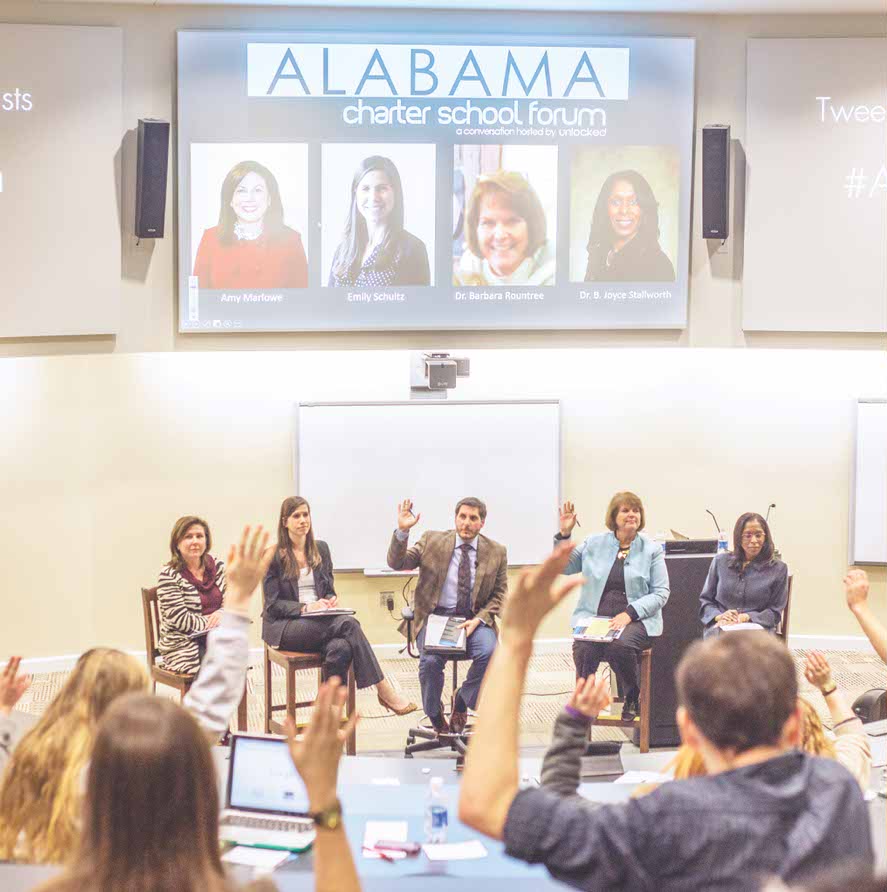Alabama is one of eight states in which the establishment of charter schools is illegal. Despite recent attempts to draft and pass charter school legislation, educators and politicians within the state still disagree on many facets of the charter school debate.
Monday night, students and faculty gathered to listen and engage in a conversation with education professionals at the Alabama Charter School Forum. The event, hosted by Unlocked UA, fostered a vibrant and nuanced dialogue about the controversy surrounding charter schools in Alabama.
The panel featured four speakers: Amy Hubbard Marlow, the research and information systems manager for the Alabama Education Association AEA; Emily Schultz, director of the Alabama Coalition for Public Charter Schools; Barbara Starnes Rountree, professor emeritus from The University of Alabama College of Education and Joyce Stallworth, associate provost for special projects and professor of English education at The University of Alabama.
The forum began with each panel member’s definition of a charter school. According to the National Alliance for Public Charter School website, a charter school is a public school. The website justifies their classification by asserting that charter schools are funded at the federal and state levels and held accountable for academic standards. But some panel members, after years of public education experience, disagreed with this definition.
“A public school is an educational institution,” Stallworth said. “They provide free education for all. I do not think charter schools qualify as public schools because they are not for all.”
Charter schools are open to anyone who wants to attend, but many have to participate in a lottery system. If a charter school were built in a community, all children in that community would have the choice to attend the charter school. But if the number of students exceeds the capacity of the school, the school will hold a random lottery to select the students to attend.
“The charter schools that I have visited all had to use the federal lottery system,” Rountree said. “Each was designed as a public school but not under the local board. These schools are more like a free agent in baseball. These were created to be very different.”
Stallworth said she agreed, and this is in part why she believes charter schools are “not for all.”
“What charter schools look like in each state is determined by the state legislation,” Schultz said in response. “Charter schools are public schools because the local, state and federal government funds them. They are open enrollment, meaning they have to take whoever wants to come.”
Schultz pointed out that magnet schools are also public schools, and they, too, are selective. She said she believed charter schools like magnet schools could be a different level of enrollment but still fell into the category of public education.
Certain groups in Alabama attempted to pass charter school legislation in 2012, but it was blocked by the AEA. Marlow explained the vision of the AEA and its reasons for shutting down the most recent charter school bill.
“AEA believes that the strength of our community schools lies in local control,” she said.
The AEA’s problem with the former bill was that it allowed charters, if denied by the local school boards, to appeal to the state in an effort to get their charter granted. Marlow said the AEA believes it is crucial the authority for community schools remain with the local districts.
“There are examples of different ways to do public education in our state,” Stallworth said.
Recognizing the success of D.C. charter schools and some charter programs like KIPP, Stallworth said, admits there have been benefits especially to students of color and low-income communities. But she raised the question, “What are the needs the public schools are not meeting?”
“There are different ways of educating students around different themes,” Stallworth said. “I don’t understand where we are with addressing needs that are unmet.”
Near the end of the discussion, all panel members acknowledged they were advocating for solutions to the same identifiable problems: faulty leadership, poor teachers and too many state regulations. The teachers they identified as “good” often ended up quitting when they became fed up with the mandates of state testing.
Stallworth said she knew a young teacher who recently resigned. The teacher said she felt she had no other choice because she could not teach in the way that she felt was correct.
“We lose teachers who would otherwise unlock kids’ minds and help them be the best that they can be,” Stallworth said.
Schultz, who previously worked as the education policy director for Gov. Robert Bentley, said she is constantly looking for ways to empower school districts that are more than capable of adopting flexible curriculum standards, similar to charter schools, and excelling. Schultz said she has seen school boards and superintendents who are visionaries, and if given the flexibility, could achieve great things. But on the flip side, she said there are also school districts and leaders who are less capable and need the state regulations to meet accountability standards.
“I think that there is an opportunity for educators with charter schools,” Schultz said. “As the policy advisor for Gov. Bentley, I spent one day a week in public schools. [Teachers] felt so restricted that they did not feel empowered professionally. I think there is a lot of opportunity for educators [in charter schools] to be able to do what they know they can do.”









